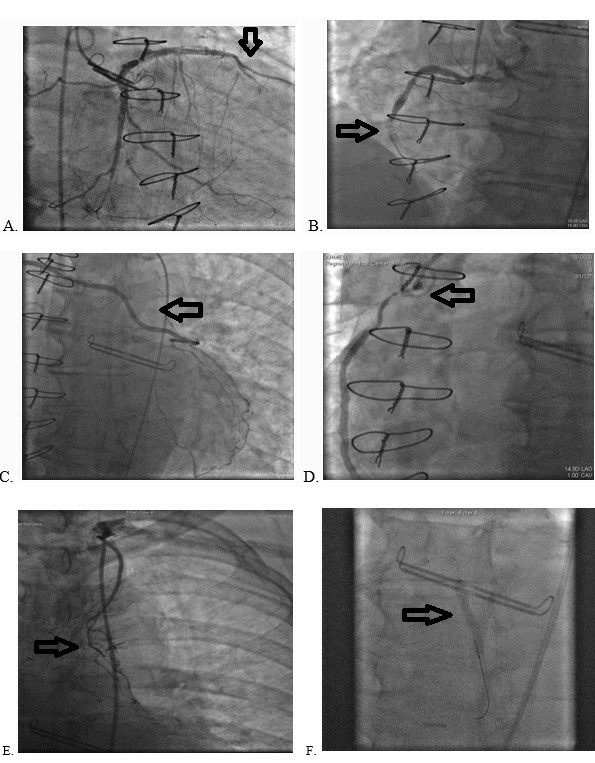Home / Journal / Annals of Cardiology
Closure of LIMA and a Saphenous vein graft within a short period of six months post CABG in presence of patent RIMA
LIMA closure patent RIMA influence of RIMA on LIMA
Mohsin. Ibrahim, and Ahmed. M. Habeeb
DOI: 10.31532/AnnCardiol.1.1.001 03 May 2019
Abstract
Appropriate revascularization decision and proper conduit selection are the most important factors to maintain adequate coronary flow and the function of the coronary bypass grafts after coronary artery bypass graft (CABG) surgery. Left internal mammary artery (LIMA) is considered to be the gold standard choice graft for bypass surgery, as its patency rates are around 90-95%, ten to fifteen years after CABG. Here, we report a case of a 58-year-old man who underwent CABG six months ago and presented for evaluation and management of worsening angina. Cardiac catheterization revealed total occlusion LIMA and severe stenosis of saphenous vein graft (SVG) in the presence of patent right internal mammary artery (RIMA).
Keywords
LIMA closure, patent RIMA, influence of RIMA on LIMA
Case Report
A 58- year old patient complains of intermittent chest pain and pressure located in the sub-sternal area without any radiation. Six months ago, he underwent 4- vessel CABG with LIMA to LAD, a jump graft of RIMA to Diagonal artery and an Obtuse Marginal (OM) artery and a reverse autogenous SVG to posterior descending artery (PDA) due to severe triple vessel disease. Follow up around six weeks post CABG surgery he showed significant improvement with complete resolution of the symptoms. He has a history of diabetes mellitus, hypertension, congestive heart failure, hyperlipidemia, left ventricular hypertrophy and arrhythmias. On further evaluation, electrocardiogram (EKG) showed sinus rhythm with sinus bradycardia, first degree AV block, right superior axis deviation and intraventricular conduction delay. 2 D Echo showed normal ejection fraction (EF) of about 60-65%, severe left ventricular hypertrophy, moderate bi-atrial enlargement and moderate to severe right ventricular enlargement.
As his symptoms were progressively worsening coronary angiography was performed which showed LIMA to LAD being atretic in its mid portion followed by total occlusion (Fig E), RIMA to OM and diagonal arteries (Fig C) were patent and SVG to RCA was sub-totally occluded proximally (Fig D). Further, management was done by staged angioplasty and stenting of SVG to RCA and left circumflex (LCX) artery (Fig F).
Figure 1. Images of coronary angiogram and intervention

A- Occluded LAD B- Occluded RCA C- Patent RIMA to diagonal D- Sub-totally occluded SVG to PDA E- Atretic LIMA to LAD F- Angioplasty and stenting of LCX artery
Discussion
Many studies over the decade have shown better long-term patency rates in patients undergoing coronary artery bypass grafting (CABG) with LIMA to the LAD. 1–3 Currently, the LIMA is the gold standard choice for bypass surgery because of the morphological characteristics of the wall that makes LIMA less prone to develop atherosclerosis and hyperplasia. 2,4 Use of multiple arterial conduits for CABG may be beneficial for long-term results.5,6
Over the past decade, use of RIMA and radial artery(RA) have emerged as competitors for the second best arterial conduit to supplement LIMA.7,8 The use of RIMA as a second arterial graft has been shown to improve long-term survival as well as provide superior freedom from re-intervention when compared with single-LIMA strategy. 9–12 In a separate study, out of a cohort of 1526 patients who had LIMA to LAD, 747 patients also received a RIMA and 779 patients received a RA graft to a non-LAD target. RIMA did not increase the incidence of 30-day mortality. At a mean follow-up of 5.7 years, RIMA was associated with a reduced risk for late death.10,13
LIMA grafts rarely develop arteriosclerosis (4%), and only about 1% develops important arteriosclerotic luminal narrowing. Early graft failure (within thirty days) is attributable to technical errors during surgery which result in dissection, hematoma, spasm or stenosis at the anastomotic site. Occlusion of the LIMA in late post-operative period is very rare, like in this case.
There are some factors other than arteriosclerosis that influence graft patency. Among them, competitive blood flow is one of the important factors affecting graft patency in early post-operative phase. It is a flow competition resulting from equilibrium between the residual flow through the native coronary artery arteries and the flow provided by the bypass graft at the anastomosis. It is mainly dependent on stenosis severity, graft diameter and length. When CABG is performed due to over assessment of the stenotic lesions, in moderately stenotic, hemodynamically stable LAD leads to competitive flow between the LIMA graft and the native LAD; that can result in occlusion of the LIMA or reversal of flow.14,15
The mechanism of competitive flow is more complex in sequential grafts in comparison with single grafts. In single graft interaction is only between the proximal inflow and the distal anastomosis outflow. In sequential composite bypass grafts, the interaction is between all the anastomosed branches within the composite graft. This leads to a delay between the pressure wave in the grafts and in the coronary arteries, especially in the more distal ones.16 Hence fractional flow reserve index (FFR) is recommended during catheterization in such cases which provides anatomic and functional information for appropriate revascularization decision 17. Other factors for LIMA graft failure include dissection, hematoma, spasm, or stenosis at the anastomosis site and the string phenomena.18,19
Conclusion
Even though it is very rare, LIMA can undergo early atherosclerosis in late post-operative period. Atherosclerosis should be carefully monitored in LIMA by symptoms and an exercise stress test or angiography if needed. In this case, we demonstrate the early closure of the LIMA in the presence of patent RIMA with a jump graft to obtuse marginal artery and the diagonal artery. We hypothesize that the probable cause of early closure of the LIMA was the competitive flow of blood from the RIMA system. Influence of competitive flow from RIMA vs. SVG on LIMA needs further study.
References
- Karthik S, Fabri BM. Left Internal Mammary Artery Usage in Coronary Artery Bypass Grafting: A Measure of Quality Control. Ann R Coll Surg Engl. 2006;88(4): 367–369.
- Cameron AA, Green GE, Brogno DA, Thornton J. Internal thoracic artery grafts: 20-year clinical follow-up. J Am Coll Cardiol. 1995; 25:188–192.
- Martínez-González B, Reyes-Hernandez CG, Quiroga-Garza A. Conduits used in coronary artery bypass grafting: A Review of Morphological Studies. Ann Thorac Cardiovasc Surg. 2017;23(2): 55–65.
- Otsuka F, Yahagi K, Sakakura K, Virmani R. Why is the mammary artery so special and what protects it from atherosclerosis. Ann Cardiothorac Surg. 2013;2(4): 519–526.
- Locker C, Schaff HV, Dearani JA, et al. Multiple arterial grafts improve late survival of patients undergoing coronary artery bypass graft surgery: analysis of 8622 patients with multivessel disease. Circulation. 2012;126(9): 1023–1030.
- Buxton BF, Shi WY, Tatoulis J, et al. Total arterial grafting in triple vessel coronary artery disease is associated with improved long-term survival. American Association for Thoracic Surgery. 2014 Annual Meeting; April 28, 2014.
- Bello SO, Peng EW, Sarkar PK. Conduits for coronary artery bypass surgery: the quest for second best. J Cardiovasc Med (Hagerstown). 2011;12(6): 411–421.
- Raja SG, Benedetto U, Jothidasan A, et al. Right internal mammary artery versus radial artery as second arterial conduit in coronary artery bypass grafting: A 10-year follow-up propensity score adjusted analysis of 1526 patients. American Association for Thoracic Surgery. 2014 Annual Meeting; April 28, 2014.
- Weiss AJ, Zhao S, Tian DH, Taggart DP, Yan TD. A meta-analysis comparing bilateral internal mammary artery with left internal mammary artery for coronary artery bypass grafting. Ann Cardiothorac Surg. 2013;2(4): 390–400.
- Buxton BF, Ruengsakulrach P, Fuller J. The right internal thoracic artery graft — benefits of grafting the left coronary system and native vessels with a high grade stenosis. Eur J Cardiothorac Surg. 2000;18(3): 255–261.
- Lytle BW, Blackstone EH, Loop FD. etal. Two internal thoracic arteries are better than one. J Thorac Cardiovasc Surg. 1999; 117: 855–872.
- Lytle BW, Blackstone EH, Sabik JF. et al. The effect of bilateral internal thoracic artery grafting on survival during 20 postoperative years. Ann Thorac Surg. 2004; 78(6):2005–12.
- RIMA Graft. Total Arterial Revascularization Touted for CABG - Medscape - May 04, 2014
- Nakajima H, Kobayashi J, Tagusari O. et al. Angiographic flow grading and graft arrangement of arterial conduits. J Thorac Cardiovasc Surg. 2006; 132(5): 1023–1029.
- Dogan P, Kuyumcu PS, Demiryapan E, Arisoy F, Ozeke O. Competitive Coronary Flow between the Native Left Anterior Descending Artery and Left Internal Mammary Artery Graft: Is It a Surrogate Angiographic Marker of Over-or-Unnecessary Revascularization Decision in Daily Practice. Int J Angiol. 2017; 26(1): 27–31.
- Glineur D, Hanet C. Competitive flow and arterial graft a word of caution. Eur J Cardiothorac Surg. 2012;41(4): 768–769.
- Pijls NH, Fearon WF, Tonino PA. et al. Fractional flow reserve versus angiography for guiding percutaneous coronary intervention in patients with multivessel coronary artery disease: 2-year follow-up of the FAME (Fractional flow reserve versus angiography for multivessel evaluation) study. J Am Coll Cardiol. 2010; 56(3): 177–184.
- Villareal RP, Mathur VS. The string phenomenon: An important cause of internal mammary artery graft failure. Tex Heart Inst J. 2000;27(4): 346–349.
- Nakamura T. Acute occlusion of the left internal mammary artery graft in the late postoperative period. J Cardiol Cases. 2014;10(2): 51–53.



